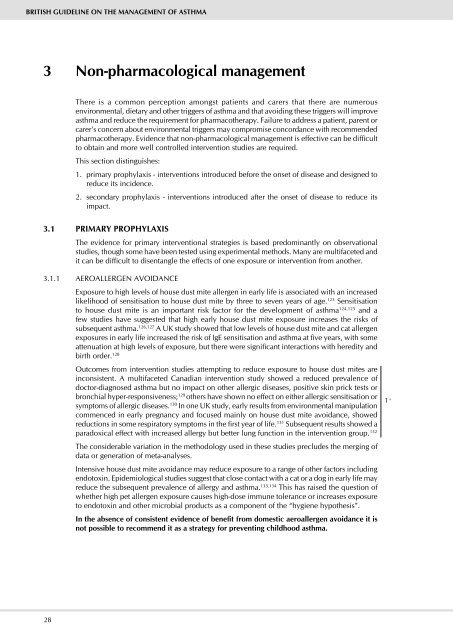sign101
sign101
sign101
Create successful ePaper yourself
Turn your PDF publications into a flip-book with our unique Google optimized e-Paper software.
British Guideline on the MAnAGeMent of AsthMA<br />
3 non-pharmacological management<br />
28<br />
There is a common perception amongst patients and carers that there are numerous<br />
environmental, dietary and other triggers of asthma and that avoiding these triggers will improve<br />
asthma and reduce the requirement for pharmacotherapy. Failure to address a patient, parent or<br />
carer’s concern about environmental triggers may compromise concordance with recommended<br />
pharmacotherapy. Evidence that non-pharmacological management is effective can be difficult<br />
to obtain and more well controlled intervention studies are required.<br />
This section distinguishes:<br />
1. primary prophylaxis - interventions introduced before the onset of disease and designed to<br />
reduce its incidence.<br />
2. secondary prophylaxis - interventions introduced after the onset of disease to reduce its<br />
impact.<br />
3.1 PriMAry ProPhylAxis<br />
The evidence for primary interventional strategies is based predominantly on observational<br />
studies, though some have been tested using experimental methods. Many are multifaceted and<br />
it can be difficult to disentangle the effects of one exposure or intervention from another.<br />
3.1.1 AEROALLERGEN AvOIDANCE<br />
Exposure to high levels of house dust mite allergen in early life is associated with an increased<br />
likelihood of sensitisation to house dust mite by three to seven years of age. 123 Sensitisation<br />
to house dust mite is an important risk factor for the development of asthma 124,125 and a<br />
few studies have suggested that high early house dust mite exposure increases the risks of<br />
subsequent asthma. 126,127 A UK study showed that low levels of house dust mite and cat allergen<br />
exposures in early life increased the risk of IgE sensitisation and asthma at five years, with some<br />
attenuation at high levels of exposure, but there were significant interactions with heredity and<br />
birth order. 128<br />
Outcomes from intervention studies attempting to reduce exposure to house dust mites are<br />
inconsistent. A multifaceted Canadian intervention study showed a reduced prevalence of<br />
doctor-diagnosed asthma but no impact on other allergic diseases, positive skin prick tests or<br />
bronchial hyper-responsiveness; 129 others have shown no effect on either allergic sensitisation or<br />
symptoms of allergic diseases. 130 In one UK study, early results from environmental manipulation<br />
commenced in early pregnancy and focused mainly on house dust mite avoidance, showed<br />
reductions in some respiratory symptoms in the first year of life. 131 Subsequent results showed a<br />
paradoxical effect with increased allergy but better lung function in the intervention group. 132<br />
The considerable variation in the methodology used in these studies precludes the merging of<br />
data or generation of meta-analyses.<br />
Intensive house dust mite avoidance may reduce exposure to a range of other factors including<br />
endotoxin. Epidemiological studies suggest that close contact with a cat or a dog in early life may<br />
reduce the subsequent prevalence of allergy and asthma. 133,134 This has raised the question of<br />
whether high pet allergen exposure causes high-dose immune tolerance or increases exposure<br />
to endotoxin and other microbial products as a component of the “hygiene hypothesis”.<br />
In the absence of consistent evidence of benefit from domestic aeroallergen avoidance it is<br />
not possible to recommend it as a strategy for preventing childhood asthma.<br />
1 +


